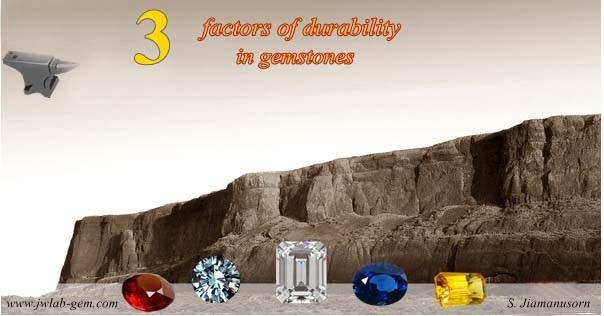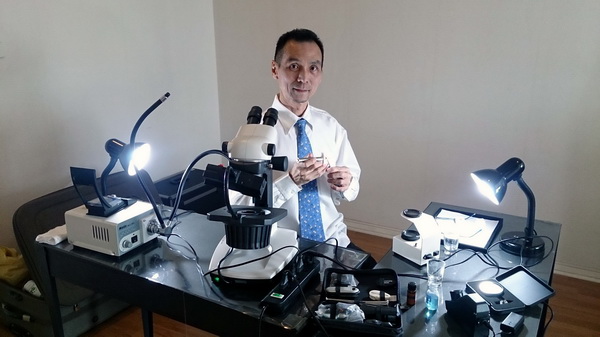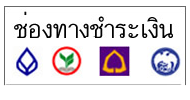Three factors of durability and gemstones

Three factors of durability and gemstones
Various assets for investment purpose other than real estate land and buildings) are: artifact ( such as painting, sculpture, antique…), jewellery ( both new and antique jewellery) and gemstone. Gemstones especially, are the most portable asset that does not require much space for storage. And it seems to be the most durable asset of all, as said “the eternal beauty”. When talking about durability in gems, we may always think of the hardness. Most people believe that hardness is the only factor of durability in gemstones. Actually, according to mineralogy, there are three essential factors to complete durability.
Hardness
Hardness is ability to resist scratch and abrasion (property of the surface). Object of higher hardness can scratch object of lower hardness. And object of the same level of hardness can also scratch each other. We classify the hardness in to 10 different levels according to 10 common minerals as a relative hardness scale call Mohs scale. The relative hardness scale begins with 1(the softest) to 10 (the hardest) : 1. Talc 2.Gypsum 3. Calcium 4.Fluorite 5.Apatite 6.Felspar (Orthoclase) 7.Quartz 8.Topaz 9.Corundum 10.Diamond
Minerals of the same hardness can scratch each other. For example, all varieties of quartz can scratch and abrade each other. Being the hardest of all minerals, diamonds can scratch and abrade all kinds of mineral and can cause scratches and abrasion to one another by themselves. To be durable, the standard hardness in gemstones should be at least 7 on the Morhs scale (hardness of quartz). And if the degree of hardness is above 7, it is even more preferable. Why? This is because quartz (SiO2 ) is the most common and abundant substance of the earth crust. Sio2 is found everywhere, it can appear as single crystal, agregate, sand or even as minute particles in the atmosphere. SiO2 is hence the major cause of scratches and abrasions to other substances. The ring is the item of jewellery that risks being scratched and abraded easily. So it is recommended that the ring gemstone should be as hard as quartz (7) or above. To select gems with appropriate hardness for use on jewellery, we can always consult the Morhs scale.
Toughness
Whereas hardness is the surface property, toughness is the property of the body of any material. It is the body property to withstand knocks and blows or, in other word, to resist fracture and cleavage. Toughness depends on the arrangement of atom in the crystal structure. Emerald and jadeite are two green gemstone of the same hardness (their hardness is 7 on the Mohs scale). When emerald is knocked against any hard object, emerald tends to chip, crack or fracture easily. If jadeite is knocked exactly in the same manner as the other, there will probably not be any damage with jadeite and it may remain intact. This is because emerald has a rather brittle body whereas jadeite has a very tough body due to its aggregated interlocking crystal structure. Jadeite is more durable as it has both good hardness and good toughness.
Diamond is the hardest of all minerals (10 on the scale), if by chance diamond is knocked at the angle of the octahedral cleavage (the weak atomic bonds in certain direction), then diamond can split or cleave off leaving a “cleavage face”(with smooth surface). Diamond possesses 4 directions of cleavage. The diamond cutters get use of this cleavage direction for splitting or slabbing diamonds. The technique of dividing diamond by giving a strike is called “diamond cleaving”. Corundum gems (ruby and sapphires) have very tough body and do not possess any cleavage in the structure. In splitting corundum we can only use saw blade to cut it.
Stability
Stability is the ability to resist alteration by physical energy (light & heat) and chemical. Amethyst, a beautiful purple gem, if exposed for a prolonged period to strong sunlight, its color will fade away and change into pale yellow or brownish yellow. So beware of exposure to sunlight for a long time in amethyst. Peridot is sensitive to thermal shock: for example in winter when we wear a peridot ring in the living room where the temperature is 25oc and suddenly we go outdoor where the temperature is -10oc. This abrupt change of temperature can cause cracks or fractures to the gemstone. Other example; avoid wearing tanzanite while cooking in front of a stove because tanzanite is quite sensitive to heat and this may cause fissure to develop and fracture the gemstone. Pearl, an organic gem, should be kept away from all chemicals and acids: hairspray, nail varnish, perfume and even acid fruit juice ( such as lemon and orange). When pearl loses its luster, we cannot restore the luster at all. Water is a component in opal structure, so it is not wise to store opal in the hot dry place. Dehydration in opal can bring about cracks and fractures. The hard gems such as diamond, ruby, sapphires, chrysoberyl and spinel are very resistant to chemical. Their resistance to acid is excellent. Diamond is a material of high thermal conductivity, so it feels cool to our touch. Anyhow, if diamond is exposed to heat for a long time at high temperature of 800oC, the diamond will react to oxygen (o2) and be burnt to ashes. This happens because diamond is a polymorph of pure carbon (like coal and graphite) and the burning point of diamond is at 800oc. In case of conflagration, diamond is easily damaged. In the same condition of heating, corundum is still intact, because corundum is more resistant to fire and will not be oxidized. The melting point of corundum is very high at 2,044oc.
We should study the factors of durability in gemstones. The discernment of physical properties in gemstones helps us to choose the appropriate gems for our personal use and to plan the special caution and cares for any individual gems so that these gems remain in good condition as long as possible.
Comparison of two hard gems
|
Corundum |
Diamond |
|
Hardness: 9 |
Hardness: 10 |
|
Toughness: Excellent |
Toughness: Good |
|
Stability: Excellent |
Stability: Good |
|
Cleavage: Non |
Cleavage: 4 directions (octahedral) |
|
Melting point: 2,044oc |
Burning point: 800oc |
See you again in the next article.
Siriwat Jiamanusorn (FGA)
คลีนิกอัญมณี
"คลีนิกอัญมณี" เป็นคอลั่มน์รวมบทความต่างๆทางอัญมณีศาตร์ ทั้งที่เกี่ยวกับแวดวงการค้าอัญมณี และในเชิงวิชาการของการตรวจวิเคราะห์พลอยประเภทต่างๆในห้องแลบ ยังรวมไปถึงเรื่องราวอัญมณีที่อยู่ในกระแสความสนใจซึ่งอาจมาจากคำถามที่พบบ่อยเป็นต้น บทความที่ผมเขียนขึ้นจะถูกรวบรวมไว้ในที่นี้ ท่านสามารถติดตามบทความใหม่ของเราที่จะนำเสนอเป็นระยะๆ รวมถึ่งการอ่านเรื่องย้อนหลังได่อีกด้วย
วัฒน์
(หมอพลอย)


SEARCH
Categories
MEMBER
- ระดับ{{userdata.dropship_level_name}}
- ไปหน้าหลักตัวแทน
- ทั้งหมด {{(order_nums && order_nums.all)?'('+order_nums.all+')':''}}
- รอการชำระเงิน {{(order_nums && order_nums.wait_payment)?'('+order_nums.wait_payment+')':''}}
- รอตรวจสอบยอดเงิน {{(order_nums && order_nums.wait_payment_verify)?'('+order_nums.wait_payment_verify+')':''}}
- รอจัดส่งสินค้า {{(order_nums && order_nums.wait_send)?'('+order_nums.wait_send+')':''}}
- รอยืนยันได้รับสินค้า {{(order_nums && (order_nums.wait_receive || order_nums.wait_confirm))?'('+(order_nums.wait_receive+order_nums.wait_confirm)+')':''}}
- รอตรวจสอบข้อร้องเรียน {{(order_nums && order_nums.dispute)?'('+order_nums.dispute+')':''}}
- เรียบร้อยแล้ว {{(order_nums && order_nums.completed)?'('+order_nums.completed+')':''}}
- ทั้งหมด {{(order_nums && order_nums.all)?'('+order_nums.all+')':''}}
- รอการชำระเงิน {{(order_nums && order_nums.wait_payment)?'('+order_nums.wait_payment+')':''}}
- รอตรวจสอบยอดเงิน{{(order_nums && order_nums.wait_payment_verify)?'('+order_nums.wait_payment_verify+')':''}}
- รอจัดส่งสินค้า {{(order_nums && order_nums.wait_send)?'('+order_nums.wait_send+')':''}}
- ส่งสินค้าเรียบร้อยแล้ว {{(order_nums && order_nums.sent)?'('+order_nums.sent+')':''}}
STATISTICS
| หน้าที่เข้าชม | 370,545 ครั้ง |
| ผู้ชมทั้งหมด | 273,296 ครั้ง |
| เปิดร้าน | 17 ก.พ. 2559 |
| ร้านค้าอัพเดท | 20 ส.ค. 2568 |
CONTACT US
LINK
ติดต่อสอบถาม
 โทรศัพท์: 081-8102763
โทรศัพท์: 081-8102763
![]() LINE ID: siriwat28
LINE ID: siriwat28
 siriwat.jiamanusorn@gmail
siriwat.jiamanusorn@gmail
 Fanpage: @jwlab.gem
Fanpage: @jwlab.gem

TRACK&TRACE

TOP เลื่อนขึ้นบนสุด





